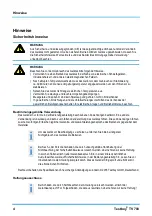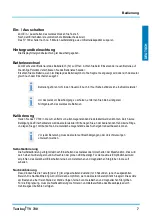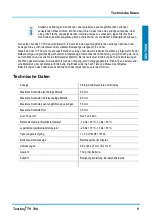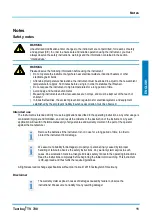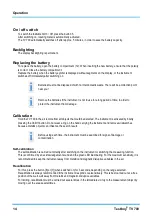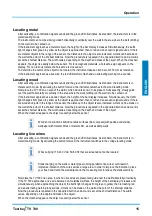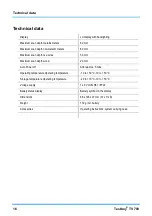
Operation
Testboy
®
TV 700
15
ENG
LI
SH
ENG
LI
SH
Locating metal
After activating, a confirmation signal sounds and the green LED illuminates. As standard, the instrument is in the
metal locating mode.
The instrument can now be slowly guided horizontally or vertically over the wall in the area where the work (drilling)
on the wall is to be carried out.
If the instrument approaches a metallic object, the height of the bar display increases. Simultaneously, the traffic
light changes from green to yellow as the object is approached, then to red and an acoustic signal sounds. If there
are metallic objects in the range of the sensor, the distance to the object is also indicated. A mark can be made on
the wall at the point of the shortest distance. Now the procedure is repeated in the opposite direction and a mark is
set at the shortest distance. The width varies, depending on the depth and mass of the object. When the crosshair
appears, the object is exactly below the sensor. For ferromagnetic materials, a horseshoe sign appears on the
display. For non-ferrous metals, the horseshoe is crossed out.
To determine the centre of the object to be located, the instrument takes an iron bar of d=18 mm as reference.
If the instrument approaches a live wire, the red LED starts to flash and an alternating warning tone sounds.
Locating wood
After activating, a confirmation signal sounds and the green LED illuminates. As standard, the instrument is in
metal search mode. By activating the button for wood, the instrument switches to the wood locating mode.
Now place the TV 700 on an area of the wall in which wood is known to be present. Subsequently, slowly guide
over the wall horizontally or vertically in the area where the work (drilling) on the wall is to be carried out.
If the instrument approaches a wooden object, the height of the bar display increases. Simultaneously, the traffic
light changes from green to yellow as the object is approached, then to red and an acoustic signal sounds. If there
are wooden objects in the range of the sensor, the distance to the object is also indicated. A mark can be made on
the wall at the point of the shortest distance. Now the procedure is repeated in the opposite direction and a mark is
set at the shortest distance. The width varies, depending on the depth and mass of the object.
When the crosshair appears, the object is exactly below the sensor.
Wooden constructions behind ceramic surfaces (tiles), carpets (with padded underside),
wallpaper with metallic fibres or metallic film, as well as damp walls.
Locating live wires
After activating, a confirmation signal sounds and the green LED illuminates. As standard, the instrument is in
metal locating mode. By activating the button for wood, the instrument switches to the voltage locating mode.
Wires carrying 110-230 V AC 50-60 Hz that are screened cannot be located.
Static charging on the walls or water pipes running parallel to live wires could result in
imprecise indication of the wires across a large area. In order to improve the indication, place
your free hand flat on the wall adjacent to the measuring tool to relieve the static electricity.
Now place the TV 700 on an area, in which no live wires are present and guide over the wall horizontally or vertically.
If the TV 700 approaches a live wire below a non-metallized surface, the height of the bar display increases and,
simultaneously, when approaching the object, the traffic light changes from green to yellow, then to flashing red
and an alternating warning tone sounds. A mark can be made on the wall at the point of the shortest distance.
Now the procedure is repeated in the opposite direction and a mark is set at the shortest distance. The width
varies, depending on the depth and mass of the object.
When the crosshair appears, the object is exactly below the sensor.
Содержание TV 700
Страница 1: ...Testboy TV 700 Version 1 1...
Страница 2: ...Testboy TV 700 Bedienungsanleitung 3 Testboy TV 700 Operating instructions 10...
Страница 17: ......
Страница 18: ......
Страница 19: ......




